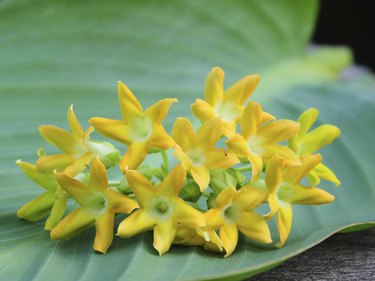
Though popular in Hawaii for the making of leis, pakalana (Telosma cordata) actually originated in India, China and Southeast Asia where its edible flowers are considered a vegetable. Also known as Chinese violet, Tonkin creeper or cowslip creeper, the vine is hardy in U.S. Department of Agriculture plant hardiness zones 10 through 11. In colder climates, it can be grown as a potted plant and moved indoors over the winter.
Envision Pakalana in Your Garden
Video of the Day
Also known as Telosma minor and Telosma odoratissima, this member of the milkweed family grows to 20 feet in the ground and up to 3 feet tall in containers. The vines feature 1 1/2- to 5-inch heart-shaped leaves and fragrant 3/5-inch diameter, 5-petal flowers that appear in dangling clusters of 15 to 30 blooms from spring into fall. Generally yellow with cream-colored centers, they open in succession and often darken to orange as they age. The vine, which bleeds white sap when cut, begins budding when days lengthen and temperatures rise above 65 degrees Fahrenheit in the spring.
Video of the Day
Grow Pakalana in the Garden
Pakalana needs a position protected from wind and ocean spray near an arbor or trellis on which it can climb. It prefers fertile and well-drained sandy loam with a pH between 6.1 and 7.5, in full sun to partial sun. If your soil is heavy clay, mix 2 inches of compost into it to lighten its texture before planting pakalana. Alternately, consider installing raised beds filled with a blend of equal parts coconut coir, compost and coarse sand or perlite to ensure good drainage. Space pakalana at least 1 foot away from other vines on the same support.
A tender perennial, pakalana must be protected from frost and winter's freezing temperatures. A sunny, south-facing wall that provides a warm microclimate may help protect the vine in USDA zone 9b. Plan to cover with frost blankets, plastic sheeting or other protective covering if frost is in the forecast.
Feed and Water Your Pakalana
Since pakalana is susceptible to root rot if its soil stays soggy, water it deeply only about once a week during dry periods. Add a 3- to 4-inch layer of mulch, pulling it back 4 inches from the stem, to slow evaporation from the soil and discourage weed seed germination. Fertilize the plant every other month from spring through autumn, with an organic bloom booster type fertilizer such as 4-10-7, using two cups per plant. After sprinkling the fertilizer onto the ground or over the mulch around the base of the plant, scratch it in and water thoroughly.
Grow Pakalana in a Pot
In climates lower than USDA zone 10, grow your pakalana in a container so you can take it inside in winter. Plant it in an 8- to 10-inch clay pot with drainage holes – filled with cactus potting soil to help prevent root rot -- and add a 3-foot pole or pot trellis on which to climb. Indoors, keep the pot on a sunny or partially shaded windowsill, where the temperature remains above 60 degrees Fahrenheit during the winter and above 70 degrees F from summer through fall to induce buds.
Water it whenever the surface of the soil feels dry to the touch and feed it every other week from spring to fall, mixing 1/2 teaspoon of a 15-15-15 water-soluble plant food with each gallon of water. Don't fertilize the vine during the winter months, when it generally stops blooming, drops into dormancy and may lose some leaves.